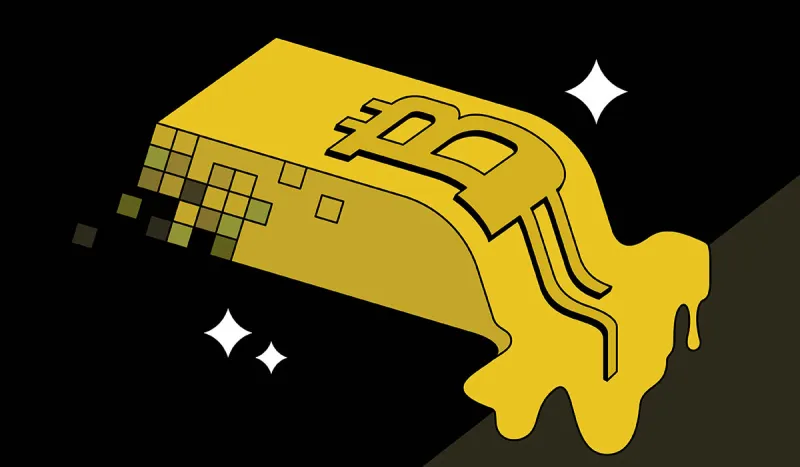
Illustration by Rose Wong
Bitcoin was supposed to be immune to the Federal Reserve’s policies. It wasn’t. The No. 1 cryptocurrency cratered earlier this year on signs the Fed would hike interest rates, which it did on March 16.
Bitcoin was supposed to be impervious to macroeconomic forces. That hasn’t proven the case either, with crypto traders reacting to soaring inflation numbers and traditional metrics such as the Bureau of Labor Statistics’ monthly jobs report.
And Bitcoin was supposed to be a “digital gold” hedge against the vicissitudes of political leaders. Russian President Vladimir Putin exposed that fallacy. Since January 1, Bitcoin has skidded 12 percent and Ethereum has lost almost a quarter of its value amid Russia’s military buildup and invasion of Ukraine. Meanwhile, actual gold climbed about 7 percent in the same period.
Before the Covid-19 pandemic, cryptocurrencies “behaved as an entirely different ecosystem,” says Goldman Sachs in a recent research report. Not anymore. Bitcoin is moving in tandem with stocks, especially tech names — the Nasdaq 100 also suffered a double-digit drop this year. For all the wizardry of blockchain technology, Bitcoin is turning out to be just another rather predictable asset instead of a fresh way to diversify portfolios.
So that begs the question: Why should institutional investors even bother with Bitcoin and its ilk if they’re going to behave just like traditional securities, albeit with a lot more volatility? Didn’t the enigmatic genius Satoshi Nakamoto introduce Bitcoin 13 years ago as a “peer-to-peer electronic cash system” that would sidestep the pernicious control of central banks and governments? While we’re at it, weren’t blockchain-based assets supposed to run in their own separate space, free from the economic and policy noise that has long pervaded the capital markets?
These are all complicated questions — made more so by the surging popularity of nonfungible tokens, the metaverse, and other crypto-powered cultural trends, which show little sign of abating even as a bear market tightens its grip. If all that wasn’t enough, Russia’s war on Ukraine has spurred efforts to use blockchain-based tokens to provide aid to the embattled nation’s citizens.
To truly understand why cryptocurrencies are behaving the way they are, you have to reckon with the sheer scale of economic and geopolitical events unfolding this year. And you have to address whether the correlation between Bitcoin and traditional securities is a phase or a sign that investors, having taken a long look, just don’t accept crypto’s premise. For some investors, it’s a matter of timing.
“Bitcoin will fulfill its thesis as an inflation hedge, but you can’t expect it to be a safe haven this early in its adoption curve,” asserts Anatoly Crachilov, the co-founder and CEO of Nickel Digital Asset Management in London. “It’s not gold yet.”
To get a bead on what comes next for this mercurial asset class, let’s set the scene. The market capitalization of crypto multiplied 16 times between March 2020 and November 2021, when it peaked at an astonishing $3 trillion. (It helped that legions of Robinhood neophytes invested their U.S. government–issued stimulus checks in silly crypto names such as Dogecoin, prompting a lot of snickering from pundits.) Though it’s easy to dismiss this six-quarter run as a speculative bubble, doing so misses the raft of concrete developments that extended the sector’s reach into industries ranging from finance to entertainment to fine art.
Ethereum, the second-most-valuable cryptocurrency network, fostered the development of decentralized finance, or DeFi, and a generation of new projects with their own blockchains and tokens. Some, like Aave and Yearn Finance, launched lending platforms, whereas others, such as Uniswap, offered investors ways to trade digital tokens. Solana and Polkadot even challenged Ethereum itself as more efficient networks for hosting decentralized applications.
Then there was the rise of NFT marketplaces like OpenSea, an online emporium brimming with digital imagery from budding artists. OpenSea and its rivals use Ether as legal tender. (Sotheby’s and Christie’s, the venerable auction houses, also accept the token for live bids on NFT sales.) At one point this year, OpenSea was handling about $200 million worth of sales volume a day on its site, according to Dune Analytics. Wall Street and City of London heavyweights have jockeyed with venture capitalists for investments in NFT start-ups, including Chase Coleman’s Tiger Global, Steven Cohen’s Point72 Ventures, and hedge fund billionaire Alan Howard.
Yet all this action was simply no match for an old bugbear that came calling at the end of 2021: inflation. When consumer prices in the U.S. soared by 7 percent last year, fears that the Fed would have to aggressively raise rates in 2022 overwhelmed all asset classes. Although in theory cryptocurrencies should have floated above the fray and, more poignantly, fulfilled their role as an anti-inflationary haven, the magnitude of the consumer price index’s biggest move in 39 years was inescapable, says Timo Lehes, co-founder of Swarm Markets, a regulated crypto exchange based in Berlin. When investors dumped equities, they also sold crypto.
Lehes says this shouldn’t be too surprising because crypto projects distribute their respective digital tokens in the marketplace from the get-go. In contrast, normal tech start-ups remain in private hands for years before going public as listed stocks. “If you think about it, crypto is essentially a prematurely public tech portfolio,” says Lehes, a longtime angel investor and former VC.
That’s a good point, but cryptocurrencies and stocks are two very different animals. For one thing, digital asset providers aren’t obliged to report regulated or even audited earnings or other types of performance data. So is the recent correlation between stocks and crypto an aberration or a deepening trend?
Bitcoin’s supporters bristle at the idea that their beloved cryptocurrency isn’t charting its own course. And yet the data is hard to refute. Earlier this year, Fundstrat Global Advisors, a New York–based research boutique, found that Bitcoin’s correlation was running close to 1 with the BVP Nasdaq Emerging Cloud Index, a benchmark of high-growth tech stocks such as Shopify and Salesforce. In a note to clients, Sean Farrell, Fundstrat’s head of digital asset strategy, said it was “indisputable” that Bitcoin was moving in lockstep with high-growth tech stocks.
Part of the reason might be that so many institutional investors have moved into the sector recently and are putting crypto on the same risk-reward spectrum as tech names. In other words, when it comes time to take off risk, there’s no use distinguishing between frothy tech shares and crypto names — no matter what the latter’s revolutionary potential may be.
Dave Weisberger, a traditional finance veteran who loves Bitcoin, agrees. “It is a highly speculative, extremely liquid asset,” says Weisberger, the co-founder and CEO of CoinRoutes, a New York–based maker of algorithmic trading tools for crypto. “So when there are major shocks, it is not remotely surprising to see high correlations between risk assets.”
But he pushes back on the notion that this correlation casts doubt on Bitcoin’s purpose. If anything, Weisberger says, Bitcoin’s design as an independent cash system is even more valid today because the cryptocurrency has proved resilient over the past decade and consumers, especially in emerging economies, want an alternative to unreliable currencies and banking systems. Moreover, a raft of projects have been using cryptocurrencies to quickly distribute aid directly to Ukrainians via the internet. UkraineDAO, which has the support of Ethereum co-founder Vitalik Buterin, raised $7 million in five days by auctioning off an NFT of the nation’s blue-and-gold flag.
Weisberger believes that the extraordinary crisis around inflation, which was triggered by a pandemic, will ebb and investors will cease judging Bitcoin and other cryptocurrencies with the same metrics long used for traditional securities. And that should end their correlation with stocks. “I think the ground is set for Bitcoin to decouple again,” he says.
But first, cryptocurrencies may have to demonstrate that their utility actually differentiates them from other asset classes — and makes them about far more than speculation.
Read more crypto columns:
Is Bitcoin Too Big to Fail?Does Crypto Have Value? A Bitcoin Pioneer Spelled It Out Years Ago.





